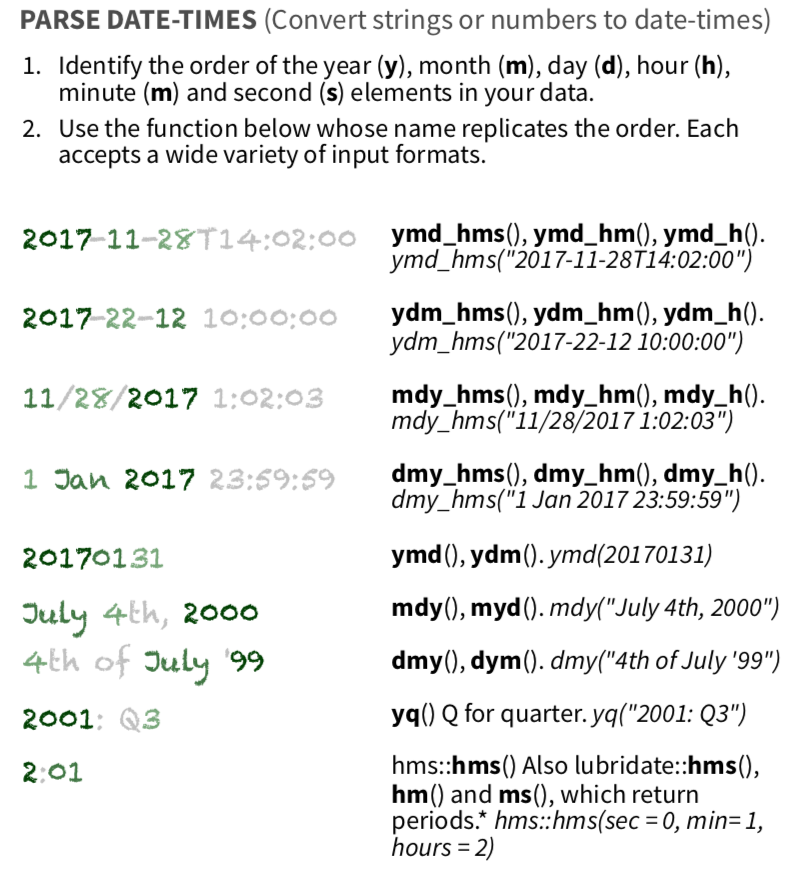Tidy Data and Dates
STAT 220
Bastola
What are tidy data?
- Each variable forms a column
- Each observation forms a row
- Each value has its own cell

Untidy data: example 1
# A tibble: 3 × 4
name wt_07_01_2021 wt_08_01_2021 wt_09_01_2021
<chr> <dbl> <dbl> <dbl>
1 Ana 100 104 NA
2 Bob 150 155 160
3 Cara 140 138 142Tidy data: example 1
library(tidyr) # for tidying messy data
library(lubridate) # for date manipulations
library(stringr) # for string manipulations
untidy_data %>%
pivot_longer(names_to = "date",
values_to = "weight",
cols = -name) %>%
mutate(date = stringr::str_remove(date,"wt_"),
date = lubridate::dmy(date)) # A tibble: 9 × 3
name date weight
<chr> <date> <dbl>
1 Ana 2021-01-07 100
2 Ana 2021-01-08 104
3 Ana 2021-01-09 NA
4 Bob 2021-01-07 150
5 Bob 2021-01-08 155
6 Bob 2021-01-09 160
7 Cara 2021-01-07 140
8 Cara 2021-01-08 138
9 Cara 2021-01-09 142Wide data
Wide data has one row per subject, with multiple columns for their repeated measurements
| id | SBP_visit1 | SBP_visit2 | SBP_visit3 |
|---|---|---|---|
| a | 132 | 100 | 111 |
| b | 120 | 106 | 112 |
| c | 130 | 126 | 128 |
| d | 118 | 116 | 108 |
Long data
Long data has multiple rows per subject, with one column for the measurement variable and another indicating from when/where the repeated measures are from
| id | visit | SBP |
|---|---|---|
| a | 1 | 132 |
| b | 1 | 120 |
| c | 1 | 130 |
| d | 1 | 118 |
| a | 2 | 100 |
| b | 2 | 106 |
| c | 2 | 126 |
| d | 2 | 116 |
| a | 3 | 111 |
| b | 3 | 112 |
| c | 3 | 128 |
| d | 3 | 108 |
Wide to long: pivot_longer()
BP_long <- BP_wide %>%
pivot_longer(names_to = "visit",
values_to = "SBP",
cols = SBP_v1:SBP_v3)
BP_long# A tibble: 12 × 4
id sex visit SBP
<chr> <chr> <chr> <dbl>
1 a F SBP_v1 130
2 a F SBP_v2 110
3 a F SBP_v3 112
4 b M SBP_v1 120
5 b M SBP_v2 116
6 b M SBP_v3 122
7 c M SBP_v1 130
8 c M SBP_v2 136
9 c M SBP_v3 138
10 d F SBP_v1 119
11 d F SBP_v2 106
12 d F SBP_v3 118Wide to long: pivot_longer()
pivot_longer lengthens data, increasing the number of rows and decreasing the number of columns.
Need to specify:
new column names
- names_to: stores row names of wide data’s columns
- .bvalues_to: stores data values
which columns to pivot
Long to wide: pivot_wider()
Long to wide: pivot_wider()
pivot_wider increases number of columns and decreases the number of rows.
Need to specify:
new column names
- names_from: get the name of the column
- values_from: get the cell values from
Separate Info
# A tibble: 12 × 5
id sex type visit SBP
<chr> <chr> <chr> <chr> <dbl>
1 a F SBP v1 130
2 a F SBP v2 110
3 a F SBP v3 112
4 b M SBP v1 120
5 b M SBP v2 116
6 b M SBP v3 122
7 c M SBP v1 130
8 c M SBP v2 136
9 c M SBP v3 138
10 d F SBP v1 119
11 d F SBP v2 106
12 d F SBP v3 118readr::parse_number()
Goal: Extract first number from the visit column and remove the characters
Make cleaned-up long data wide
# A tibble: 4 × 4
id sex visit SBP
<chr> <chr> <dbl> <dbl>
1 a F 1 130
2 a F 2 110
3 a F 3 112
4 b M 1 120- Problem: have numbers as column names
- Solution: have row names start with the
keycolumn’s name separated by a character
Group Activity 1

- Please clone the
ca8-yourusernamerepository from Github - Please do the problem 1 in the class activity for today
10:00
Dates with lubridate
Convert characters to special “Date” type
Easy date magic examples:
- add and subtract dates
- convert to minutes/years/etc
- change timezones
- add 1 month to a date…
What kind of date do you have?

Parsing Complex Dates
library(lubridate)
complex_dates <- tibble(
name = c("Yi", "Mo", "Dee"),
dob = c("31-October-1952 14:30:15",
"12-Jan-1984 22:15:00",
"02-Feb-2002 10:45:30")
)
complex_dates %>%
mutate(dob_date = dmy_hms(dob)) %>%
knitr::kable() # to make nice tables| name | dob | dob_date |
|---|---|---|
| Yi | 31-October-1952 14:30:15 | 1952-10-31 14:30:15 |
| Mo | 12-Jan-1984 22:15:00 | 1984-01-12 22:15:00 |
| Dee | 02-Feb-2002 10:45:30 | 2002-02-02 10:45:30 |
Advanced Date Arithmetic
complex_dates %>%
mutate( dob_date = dmy_hms(dob),
dob_year = year(dob_date),
time_since_birth = interval(dob_date, now()),
age_exact = time_length(time_since_birth, unit = "years")) %>%
knitr::kable()| name | dob | dob_date | dob_year | time_since_birth | age_exact |
|---|---|---|---|---|---|
| Yi | 31-October-1952 14:30:15 | 1952-10-31 14:30:15 | 1952 | 1952-10-31 14:30:15 UTC–2024-05-15 03:37:38 UTC | 71.53701 |
| Mo | 12-Jan-1984 22:15:00 | 1984-01-12 22:15:00 | 1984 | 1984-01-12 22:15:00 UTC–2024-05-15 03:37:38 UTC | 40.33668 |
| Dee | 02-Feb-2002 10:45:30 | 2002-02-02 10:45:30 | 2002 | 2002-02-02 10:45:30 UTC–2024-05-15 03:37:38 UTC | 22.28061 |
Advanced Date Arithmetic: alternate
complex_dates %>%
mutate(dob_date = dmy_hms(dob),
age_exact = as.numeric(interval(dob_date, now()) / years(1))) %>%
knitr::kable()| name | dob | dob_date | age_exact |
|---|---|---|---|
| Yi | 31-October-1952 14:30:15 | 1952-10-31 14:30:15 | 71.53701 |
| Mo | 12-Jan-1984 22:15:00 | 1984-01-12 22:15:00 | 40.33668 |
| Dee | 02-Feb-2002 10:45:30 | 2002-02-02 10:45:30 | 22.28061 |
Creating Date-Time Objects with make_datetime()
Advanced Date-Time Arithmetic
date_time <- tibble(date = ymd("2024-01-13", "2024-03-06", "2025-06-30"))
date_time %>%
mutate(add_month = date %m+% months(1),
add_year = date %m+% years(1),
subtract_week = date %m-% weeks(1)) %>%
knitr::kable()| date | add_month | add_year | subtract_week |
|---|---|---|---|
| 2024-01-13 | 2024-02-13 | 2025-01-13 | 2024-01-06 |
| 2024-03-06 | 2024-04-06 | 2025-03-06 | 2024-02-28 |
| 2025-06-30 | 2025-07-30 | 2026-06-30 | 2025-06-23 |
Duration and Time Differences
time_diff_example <- tibble(
start_date = ymd("2024-01-03"),
end_date = ymd("2024-03-17")
)
time_diff_example %>%
mutate(time_diff = end_date - start_date,
duration_days = time_length(time_diff, unit = "days"),
duration_weeks = as.duration(time_diff) / dweeks(1),
duration_months = as.duration(time_diff) / dmonths(1),
duration_years = as.duration(time_diff) / dyears(1)) %>%
knitr::kable()| start_date | end_date | time_diff | duration_days | duration_weeks | duration_months | duration_years |
|---|---|---|---|---|---|---|
| 2024-01-03 | 2024-03-17 | 74 days | 74 | 10.57143 | 2.431211 | 0.202601 |
Group Activity 2

- Please do the remaining problems in the class activity.
- Submit to Gradescope on moodle when done!
10:00
